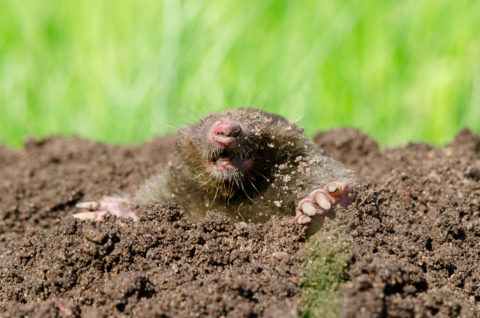
Moles can be the bane of your lawn. But moles are also a sign that your yard is a thriving, healthy ecosystem.
Are you seeing signs of moles in your lawn? Many people struggle with these small but destructive animals. Here are some tips on how to manage moles in your yard.
Mole hills and tunnels
Moles tunnel beneath the soil looking for food. In the process, they may create long ridges of soil. The tunnels create weak spots and holes in a lawn. The moles also push mounds of soil to the surface, and they may pile up soil outside tunnel entrances.
Moles: fun facts
From The Old Farmer’s Almanac:
“Moles are often mistaken for rodents, but they are not related to mice, rats and other rodents. Their diet includes insect larvae, spiders, earthworms and lawn pests such as slugs and grubs. They do not intentionally eat plant material.
“To meet their high energy requirements, moles eat just about 24/7. They often consume the equivalent of 60–90% of their body weight in a single day and may tunnel 100 feet in the process.
“Moles are well adapted to the darkness of subterranean living. Nearly blind, they compensate with their keen senses of smell, hearing and touch.
“As they dig through the earth with their large, shovel-like forepaws, their tiny eyes are protected from dirt by thin membranes. Their nostrils face to the sides of their pointed snouts to avoid being clogged, and they lack external ears.”
Benefits of moles: yes, really!
Moles are part of a healthy ecological system. If you have them in your yard, it means you have rich, healthy soil, with beneficial insects and organisms like worms. Does that make you feel a little bit better?
Moles eat worms, slugs and soil insects. Many people blame them for eating bulbs and the fleshy roots of ornamentals. According to The Old Farmer’s Almanac, chipmunks, mice and voles are actually the culprits.
As moles dig their underground tunnels, they create channels for air and water to move through the soil. This helps plant growth.
What you can do to manage moles
We think the best solution is to tolerate moles when possible, since they play such a beneficial role in your garden’s ecology.
Rake the mounds as soon as you notice them in the lawn. This will prevent the soil from killing the lawn. Rake the extra soil into the lawn to provide a light topdressing.
You may want to consider replacing part of your lawn with garden beds. This will attract birds, butterflies and other pollinators, while hiding the mole damage.
Traps are effective, but difficult to use correctly. Traps can be dangerous, so get and follow detailed instructions. Leg hold traps are illegal in Washington.
Castor oil and noisemakers have mixed results. Castor-oil repellents may help in the short term. Devices that make noise or vibrations may sometimes work. Flooding and fumigating rarely work, since nearby moles will move into the vacated tunnel.
You may want to install a physical barrier. If you know the moles are coming from a certain area, dig a trench and insert bamboo cloth or hardware cloth. The barrier should be at least six to 12 inches deep. This will protect the roots of young plants. Older trees and shrubs are usually not affected. Digging and installing a barrier can be labor-intensive.
Don’t use a pesticide that kills grubs or earthworms. The moles will return, their damage won’t disappear, and in the process you will kill earthworms that help your soil. Pesticides may also harm other wildlife, pets and children.

I won’t kill the moles but they do seem to take every ounce of nutrients out of the area they inhabit until they move to another. But once they do move to a new area i fertilize the old and the area is like new in six months. Works for us both.
Thanks for your comment. I’m glad you are finding an environmentally friendly way to deal with the moles and keep your landscape healthy.